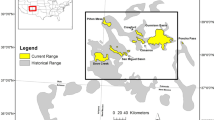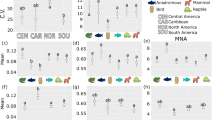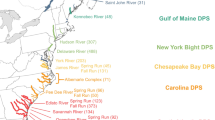Abstract
Technological advancements have allowed geneticists to exploit an increasing array of molecular markers, many of which have different properties and may provide contrasting insights into the evolutionary history and structure of populations. This has important consequences for conservation managers attempting to identify units at which to conserve intraspecific diversity. In this study we compared the inferences derived from nuclear microsatellites and restriction-site associated DNA (RADseq) data for a threatened freshwater fish, the bull trout Salvelinus confluentus. For both marker types we generated data for the same suite of individuals collected from 24 populations distributed across the species range. The RADseq data were low coverage (mean site coverage < 3X), so we implemented a probabilistic genotyping approach. We performed a comparable suite of analyses for both datasets. Both datasets revealed similar broad patterns of subdivision that reflected primary evolutionary lineages (Coastal and Interior clades). However, the RADseq more clearly and consistently identified the hierarchical phylogenetic structure. Some populations had varying assignments to these lineages depending on the dataset. RADseq data also suggested admixture has shaped the genomic character of several populations. Such a signal was not apparent with the microsatellites, suggesting that the datasets are revealing different aspects of population history. Our study provides a valuable case study in how advances in molecular technology can enhance our understanding of a relatively well-studied species. It also underscores the importance of framing findings generated with high-throughput sequencing technology within the context of past research to enhance conservation decision making.




Similar content being viewed by others
Data availability
Data for this study will be submitted to the Dryad Digital Repository after the manuscript is accepted for publication.
References
Angers B, Bernatchez L, Angers A, Desgroseillers L (1995) Specific microsatellite loci for brook charr (Salvelinus fontinalis Mitchill) reveal strong population subdivision on a microgeographic scale. J Fish Biol 47:177–185
Ardren WR, DeHaan PW, Smith CT et al (2011) Genetic structure, evolutionary history, and conservation units of bull trout in the coterminous United States. Trans Am Fish Soc 140:506–525. https://doi.org/10.1080/00028487.2011.567875
Baird, NA, Etter PD, Atwood TS, Currey MC, Shiver AL, Lewis ZA, Selker EU, Cresko WA, Johnson EA (2008) Rapid SNP discovery and genetic mapping using sequenced RAD markers. PLoSOne 3:e3376
Besnier F, Glover KA (2013) Parallel structure: a R package to distribute parallel runs of the population genetics program STRUCTURE on multi-core computers. PLoS ONE 8:1–9. https://doi.org/10.1371/journal.pone.0070651
Blankenship SM, Campbell MR, Hess JE et al (2011) Major lineages and metapopulations in Columbia River Oncorhynchus mykiss are structured by dynamic landscape features and environments. Trans Am Fish Soc 140:665–684. https://doi.org/10.1080/00028487.2011.584487
Bradbury IR, Hamilton LC, Dempson B et al (2015) Transatlantic secondary contact in Atlantic Salmon, comparing microsatellites, a single nucleotide polymorphism array and restriction-site associated DNA sequencing for the resolution of complex spatial structure. Mol Ecol 24:5130–5144. https://doi.org/10.1111/mec.13395
Buerkle AC, Gompert Z (2013) Population genomics based on low coverage sequencing: how low should we go? Mol Ecol 22:3028–3035. https://doi.org/10.1111/mec.12105
Catchen J, Hohenlohe PA, Bassham S et al (2013) Stacks: an analysis tool set for population genomics. Mol Ecol 22:3124–3140. https://doi.org/10.1111/mec.12354
Corander J, Majander KK, Cheng L, Merilä J (2013) High degree of cryptic population differentiation in the Baltic Sea herring Clupea harengus. Mol Ecol 22:2931–2940. https://doi.org/10.1111/mec.12174
Costello AB, Down TE, Pollard SM et al (2003) Influence of history and contemporary stream hydrology on the evolution of genetic diversity within species: an examination of microsatellite DNA variation in bull trout, Salvelinus confluentus (Pisces: Salmonidae). Evolution 57:328. https://doi.org/10.1554/0014-3820(2003)057%5B0328:TIOHAC%5D2.0.CO;2
Crane PA, Lewis CJ, Kretschmer EJ, Miller SJ, Spearman WJ, DeCicco AL, Lisac MJ, Wenburg JK (2004) Characterization and inheritance of seven microsatellite loci from Dolly Varden, Salvelinus malma, and cross-species amplification in Arctic char, S. alpinus. Con Gen 5:737–741
DeFaveri J, Viitaniemi H, Leder E, Merilä J (2013) Characterizing genic and nongenic molecular markers: comparison of microsatellites and SNPs. Mol Ecol Resour 13:377–392. https://doi.org/10.1111/1755-0998.12071
DeHaan PW, Ardren WR (2005) Characterization of 20 highly variable tetranucleotide microsatellite loci for bull trout (Salvelinus confluentus) and cross-amplification in other Salvelinus species. Mol Ecol Notes 5:582–585. https://doi.org/10.1111/j.1471-8286.2005.00997.x
DeHaan PW, Bernall SR, Dossantos JM et al (2011) Use of genetic markers to aid in re-establishing migratory connectivity in a fragmented metapopulation of bull trout (Salvelinus confluentus). Can J Fish Aquat Sci 68:1952–1969. https://doi.org/10.1139/f2011-098
DeYoung RW, Honeycutt RL (2008) The molecular toolbox: genetic techniques in wildlife ecology and management. J Wildl Manage 69:1362–1384. https://doi.org/10.2193/0022-541X(2005)69%5B1362:TMTGTI%5D2.0.CO;2
Elbers JP, Clostio RW, Taylor SS (2016) Population genetic inferences using immune gene SNPs mirror patterns inferred by microsatellites. Mol Ecol Resour 17:481–491. https://doi.org/10.1111/1755-0998.12591
Evanno G, Regnaut S, Goudet J (2005) Detecting the number of clusters of individuals using the software STRUCTURE: a simulation study. Mol Ecol 14:2611–2620. https://doi.org/10.1111/j.1365-294X.2005.02553.x
Excoffier L, Smouse PE, Quattro JM (1992) Analysis of molecular variance inferred from metric distances among DNA haplotypes. Genetics 131:479–491. https://doi.org/10.1007/s00424-009-0730-7
Excoffier L, Foll M, Petit RJ (2009) Genetic consequences of range expansions. Annu Rev Ecol Evol Syst 40:481–501. https://doi.org/10.1146/annurev.ecolsys.39.110707.173414
Falush D, Stephens M, Pritchard JK (2003) Inference of population structure using multilocus genotype data: linked loci and correlated allele frequencies. Genetics 164:1567–1587
Fumagalli M, Vieira FG, Korneliussen TS et al (2013) Quantifying population genetic differentiation from next-generation sequencing data. Genetics 195:979–992. https://doi.org/10.1534/genetics.113.154740
Fumagalli M, Vieira FG, Linderoth T, Nielsen R (2014) NgsTools: methods for population genetics analyses from next-generation sequencing data. Bioinformatics 30:1486–1487. https://doi.org/10.1093/bioinformatics/btu041
Gompert Z, Buerkle CA (2016) What, if anything, are hybrids: enduring truths and challenges associated with population structure and gene flow. Evol Appl 9:909–923. https://doi.org/10.1111/eva.12380
Groves CP, Cotterill FPD, Gippoliti S et al (2017) Species definitions and conservation: a review and case studies from African mammals. Conserv Genet 18:1247–1256. https://doi.org/10.1007/s10592-017-0976-0
Haasl RJ, Payseur B (2010) Multi-locus inference of population structure: a comparison between single nucleotide polymorphisms and microsatellites. Heredity 106:158–171. https://doi.org/10.1038/hdy.2010.21
Hodel RGJ, Segovia-Salcedo MC, Landis JB et al (2016) The report of my death was an exaggeration: a review for researchers using microsatellites in the 21st Century. Appl Plant Sci 4:1600025. https://doi.org/10.3732/apps.1600025
Hodel RGJ, Chen S, Payton AC et al (2017) Adding loci improves phylogeographic resolution in red mangroves despite increased missing data: comparing microsatellites and RAD-Seq and investigating loci filtering. Sci Rep 7:17598. https://doi.org/10.1038/s41598-017-16810-7
Jeffries DL, Copp GH, Lawson Handley L et al (2016) Comparing RADseq and microsatellites to infer complex phylogeographic patterns, an empirical perspective in the Crucian carp, Carassius carassius, L. Mol Ecol 25:2997–3018. https://doi.org/10.1111/mec.13613
Jensen EL, Govindarajulu P, Russello M (2013) When the shoe doesn’t fit: applying conservation unit concepts to western painted turtles at their northern periphery. Conserv Genet 15:261–274. https://doi.org/10.1007/s10592-013-0535-2
Jombart T (2008) Adegenet: a R package for the multivariate analysis of genetic markers. Bioinformatics 24:1403–1405. https://doi.org/10.1093/bioinformatics/btn129
Kohn MH, Murphy WJ, Ostrander EA, Wayne RK (2006) Genomics and conservation genetics. Trends Ecol Evol 21:629–637. https://doi.org/10.1016/j.tree.2006.08.001
Korneliussen TS, Albrechtsen A, Nielsen R (2014) ANGSD: analysis of next generation sequencing data. BMC Bioinform 15:356. https://doi.org/10.1186/s12859-014-0356-4
Langmead B, Salzberg SL (2012) Fast gapped-read alignment with Bowtie 2. Nat Methods 9:357–359. https://doi.org/10.1038/nmeth.1923
Li H, Handsaker B, Wysoker A et al (2009) The sequence alignment/map format and SAMtools. Bioinformatics 25:2078–2079. https://doi.org/10.1093/bioinformatics/btp352
Liu N, Chen L, Wang S et al (2005) Comparison of single-nucleotide polymorphisms and microsatellites in inference of population structure. BMC Genet 6:26. https://doi.org/10.1186/1471-2156-6-S1-S26
Luikart G, Allendorf FW, Cornuet J-M, Sherwin WB (1998) Distortion of allele frequency distributions provides a test for recent population bottlenecks. J of Heredity 89:238–247
Marin K, Coon A, Fraser DJ (2017) Traditional ecological knowledge reveals the extent of sympatric lake trout diversity and habitat preferences. Ecol Soc 22:20. https://doi.org/10.5751/ES-09345-220220
Martin CH, Cutler JS, Friel JP et al (2015) Complex histories of repeated gene flow in Cameroon crater lake cichlids cast doubt on one of the clearest examples of sympatric speciation. Evolution 69:1406–1422. https://doi.org/10.1111/evo.12674
Mastretta-Yanes A, Arrigo N, Alvarez N et al (2015) Restriction site-associated DNA sequencing, genotyping error estimation and de novo assembly optimization for population genetic inference. Mol Ecol Resour 15:28–41. https://doi.org/10.1111/1755-0998.12291
McDevitt AD, Mariani S, Hebblewhite M et al (2009) Survival in the Rockies of an endangered hybrid swarm from diverged caribou (Rangifer tarandus) lineages. Mol Ecol 18:665–679. https://doi.org/10.1111/j.1365-294X.2008.04050.x
McKenna A, Hanna M, Banks E et al (2010) The genome analysis toolkit: a mapreduce framework for analyzing next-generation DNA sequencing data. Genome Res 20:1297–1303. https://doi.org/10.1101/gr.107524.110.20
McMahon BJ, Teeling EC, Höglund J (2014) How and why should we implement genomics into conservation? Evol Appl 7:999–1007. https://doi.org/10.1111/eva.12193
McPhail JD, Baxter JS (1996) A review of bull trout (Salvelinus confluentus) life-history and habitat use in relation to compensation and improvement opportunities. Department of Zoology, University of British Columbia, Vancouver
Miller MR, Dunham JP, Amores A, Cresko WA, Johnson EA (2007) Rapid and cost-effective polymorphism identification and genotyping using restriction site associated DNA (RAD) markers. Genome Res 17:240–248
Mogen JT, Kaeding LR (2005) Identification and characterization of migratory and nonmigratory Bull Trout populations in the St. Mary River Drainage, Montana. Trans Amer Fish Soc 134:841–852
Narum SR, Hess JE, Matala AP (2010) Examining genetic lineages of Chinook salmon in the Columbia River Basin. Trans Am Fish Soc 139:1465–1477. https://doi.org/10.1577/T09-150.1
Nielsen R, Paul JS, Albrechtsen A, Song YS (2011) Genotype and SNP calling from next-generation sequencing data. Nat Rev Genet 12:443–451. https://doi.org/10.1038/nrg2986
Nielsen R, Korneliussen T, Albrechtsen A et al (2012) SNP calling, genotype calling, and sample allele frequency estimation from new-generation sequencing data. PLoS ONE 7:e37558. https://doi.org/10.1371/journal.pone.0037558
Northcote TG (1997) Potamodromy in Salmonidae—living and moving in the fast lane. N Amer J Fish Manag 17:1029–1045
Paris JR, Stevens JR, Catchen JM (2017) Lost in parameter space: a road map for Stacks. Methods Ecol Evol 8:1360–1373. https://doi.org/10.1111/2041-210X.12775
Piccolo JJ (2016) Conservation genomics: coming to a salmonid near you. J Fish Biol 89:2735–2740. https://doi.org/10.1111/jfb.13172
Pickrell J, Pritchard J (2012) Inference of population splits and mixtures from genome-wide allele frequency data. PLoS Genet 8:e1002967. https://doi.org/10.1371/journal.pgen.1002967
Pisa G, Orioli V, Spilotros G et al (2015) Detecting a hierarchical genetic population structure: the case study of the Fire Salamander (Salamandra salamandra) in Northern Italy. Ecol Evol 5:743–758. https://doi.org/10.1002/ece3.1335
Polfus JL, Manseau M, Simmons D et al (2016) Łeghágots’enetę (learning together): the importance of indigenous perspectives in the identification of biological variation
Pritchard JK, Stephens M, Donnelly P (2000) Inference of population structure using multilocus genotype data. Genetics 155:945–959
Puckett EE (2017) Variability in total project and per sample genotyping costs under varying study designs including with microsatellites or SNPs to answer conservation genetic questions. Conserv Genet Resour 9:289–304. https://doi.org/10.1007/s12686-016-0643-7
Putman AI, Carbone I (2014) Challenges in analysis and interpretation of microsatellite data for population genetic studies. Ecol Evol 4:4399–4428. https://doi.org/10.1002/ece3.1305
Ramey IIRR, Wehausen JD, Liu H-P et al (2007) How King et al. (2006) define an “evolutionary distinction”. of a mouse subspecies: a response. Mol Ecol 16:3518–3521. https://doi.org/10.1111/j.1365-294X.2007.03397.x
R Core Team (2015) R: a language and environment for statistical computing. R Foundation for Statistical Computing. Vienna, Austria. https://www.R-project.org
Rieman BE, McIntyre JD (1993) Demographic and habitat requirements for conservation of bull trout. Ogen, Tampa
Rieman BE, Dunham JB (2000) Metapopulations and salmonids: a synthesis of life history patterns and empirical observations. Eco Fresh Fish 9:51–64
Skotte L, Korneliussen TS, Albrechtsen A (2013) Estimating individual admixture proportions from next generation sequencing data. Genetics 195:693–702. https://doi.org/10.1534/genetics.113.154138
Spruell P, Rieman BE, Knudsen KL et al (1999) Genetic population structure within streams: microsatellite analysis of bull trout populations. Ecol Freshw Fish 8:114–121. https://doi.org/10.1111/j.1600-0633.1999.tb00063.x
Spruell P, Hemmingsen AR, Howell PJ et al (2003) Conservation genetics of bull trout: geographic distribuition of variation at microsatellite loci. Conserv Genet 4:17–29
Sunnucks P (2000) Efficient genetic markers for population biology. Trends Ecol Evol 15:199–203. https://doi.org/10.1016/S0169-5347(00)01825-5
Taylor EB, Pollard S, Louie D (1999) Mitochondrial DNA variation in bull trout (Salvelinus confluentus) from northwestern North America: implications for zoogeography and conservation. Mol Ecol 8:1155–1170. https://doi.org/10.1046/j.1365-294X.1999.00674.x
Thrasher DJ, Butcher BG, Campagna L et al (2018) Double-digest RAD sequencing outperforms microsatellite loci at assigning paternity and estimating relatedness: a proof of concept in a highly promiscuous bird. Mol Ecol Resour. https://doi.org/10.1111/1755-0998.12771
Twyford AD, Ennos RA (2012) Next-generation hybridization and introgression. Heredity 108:179–189. https://doi.org/10.1038/hdy.2011.68
U.S. Fish and Wildlife Service (2015) Recovery plan for the coterminous United States population of bull trout. Portland, OR
Unger S Jr, Sutton OR, Williams T R (2013) Population genetics of the eastern hellbender (Cryptobranchus alleganiensis alleganiensis) across multiple spatial scales. PLoS ONE 8:1–14. https://doi.org/10.1371/journal.pone.0074180
Urban J (2014) How does bowtie2 assign MAPQ scores? [Blog] Biofinysics. URL: http://biofinysics.blogspot.com/2014/05/how-does-bowtie2-assign-mapq-scores.html
Väli Ü, Saag P, Dombrovski V et al (2010) Microsatellites and single nucleotide polymorphisms in avian hybrid identification: a comparative case study. J Avian Biol 41:34–49. https://doi.org/10.1111/j.1600-048X.2009.04730.x
Waples RS, Gaggiotti O (2006) What is a population? An empirical evaluation of some genetic methods for identifying the number of gene pools and their degree of connectivity. Mol Ecol 15:1419–1439. https://doi.org/10.1111/j.1365-294X.2006.02890.x
Warnock WG, Rasmussen JB, Taylor EB (2010) Genetic clustering methods reveal bull trout (Salvelinus confluentus) fine-scale population structure as a spatially nested hierarchy. Conserv Genet 11:1421–1433. https://doi.org/10.1007/s10592-009-9969-y
Wayne RK, Shaffer HB (2016) Hybridization and endangered species protection in the molecular era. Mol Ecol 81:778–793. https://doi.org/10.1111/mec.13642
Whiteley AR, Spruell P, Rieman BE, Allendorf FW (2006) Fine-scale genetic structure of bull trout at the southern Llimit of their distribution. Trans Am Fish Soc 135:1238–1253. https://doi.org/10.1577/T05-166.1
Zink RM, Barrowclough GF (2008) Mitochondrial DNA under siege in avian phylogeography. Mol Ecol 17:2107–2121. https://doi.org/10.1111/j.1365-294X.2008.03737.x
Acknowledgements
Funding for this project was provided by the US Fish and Wildlife Service Fish and Aquatic Conservation Program and Washington State general funds. We sincerely thank the numerous individual biologists and technicians from the different federal, state, tribal, and non-governmental agencies who collected tissue samples used in these analyses. We also thank Sewall Young and Ken Warheit (WDFW) for sharing scripts for running Stacks. The findings and conclusions in this paper are those of the authors and do not necessarily represent the views of the US Fish and Wildlife Service.
Author information
Authors and Affiliations
Corresponding author
Electronic supplementary material
Below is the link to the electronic supplementary material.
Rights and permissions
About this article
Cite this article
Bohling, J., Small, M., Von Bargen, J. et al. Comparing inferences derived from microsatellite and RADseq datasets: a case study involving threatened bull trout. Conserv Genet 20, 329–342 (2019). https://doi.org/10.1007/s10592-018-1134-z
Received:
Accepted:
Published:
Issue Date:
DOI: https://doi.org/10.1007/s10592-018-1134-z




